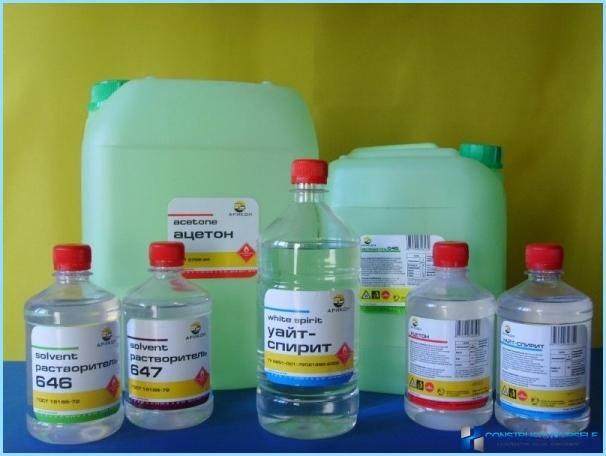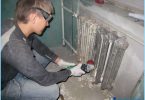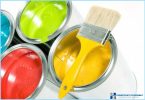The contents
Solvents, organic and inorganic volatile compounds, allowing to dissolve various substances. They are also used to obtain the required consistency and improve the characteristics of materials.
General characteristics of solvents ↑
Solvents (thinners) may be created on the basis of single component and multiple components. The composition can be solid, liquid and gaseous substances, but most of the solvents are in liquid phase.
Solvent compositions are mainly evaluated on characteristics such as:
- appearance;
- the percentage of water;
- density;
- volatility.
The quality of the compositions and technology of their use due to their certain special characteristics, namely:
- content of chemical additives;
- toxicity;
- acidity;
- the Flammability and other indicators.
Solvents are used in mechanical engineering and instrument making, in many branches of industry, in footwear and leather goods production in the medical industry, laboratories and so on.
The types of solvents ↑
For each type of work using a specific kind of solvent composition:
- for oil paints (petrol, white spirit, turpentine);
- for glyptal and bituminous paints and varnishes (solvent, xylene and turpentine);
- for perchlorovinyl paints (acetone);
- for adhesives and waterborne paints;
- for domestic use.
The solvent 646 ↑
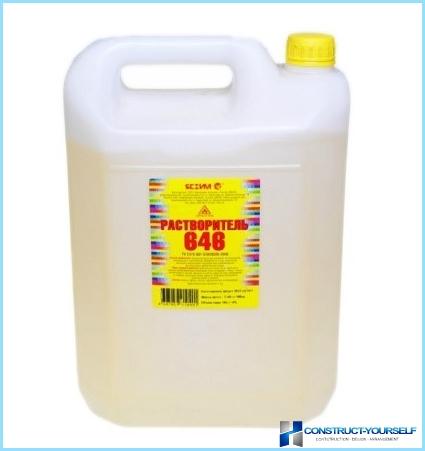
In the last century began to produce and to use solvents which are mainly used for diluting various nitrovarnishes and nitrocellulose. Currently thinning compositions are used not only for dilution of coatings, but also for removing stains, cleaning tool, various surfaces, and for other purposes. The solvent 646, a part of which is acetone, ethanol, toluene and other ingredients, used in almost all finishing works.
The solvent 646, which is designed for use with nitrocellulose and nitro lacquer, epoxy and glyptal primers, after the complete evaporation gives the paint extra Shine. This thinning squad is the most active among similar means, therefore, its use must be carefully not to accidentally damaging the lower layer of paint.
The advantages of solvent 646 ↑
Before proceeding to the consideration of direct composition, is to begin to dwell on its main advantages:
- availability and small price. These compounds can now be purchased at almost any hardware store or building materials market;
- the ease of use. Instructions for use indicated on the packaging;
- a wide range of applications, because it can be used with almost any paint and varnish materials;
- allows the paint to dry faster, thus forming on the surface a shiny and smooth surface.
The solvent 646 is in accordance with GOST 18188-72 is a colorless or slightly yellowish liquid with specific smell. It is widely applied to household and industry for degreasing surfaces and breeding of various types of paint. Through this diluent in paints give the desired viscosity. Besides, with it perfectly removes organic stains and cleaned various tools.
In addition to the positive properties thinning composition has some drawbacks, namely:
- easy ignition;
- toxicity;
- odor.
The solvent 646: properties and specifications ↑
The solvent 646 is universal and sufficiently effective due to its chemical composition. The diluent consists of toluene (50%), ethanol (15%), butyl acetate (10%), butanol (10%), ethylcellsolve (8%) and acetone (7%). Technical characteristics of the solvent 646 in most cases depend on the given proportions.
This mixture, representing the connection of volatile organic compounds, has the following properties:
- the boiling temperature is +59?C;
- auto-ignition temperature +403?C;
- does not freeze and is gaining strength;
- the density of the solvent 646 is 0.87 g/cm³.
Among other things, is to see the passport of solvent 646, though many of the figures for the average person to have no value, but the manufacturing process on their basis will be able to recommend or deny the use of this composition. The passport also lists the following parameters:
- the acid number of 0.06 mg Koh/g;
- the number of coagulation – 40 y/o;
- mass fraction of water – 0,09%;
- volatility – 12;
- the specific weight is 0.68 kg/l.
What is the difference between the solvent 646 and 647 ↑
When selecting the solvent composition is sometimes difficult to determine the specific kind currently on the market are numerous varieties of diluent – 646, 647, 648, and so on. In order to choose the right type of makeup you should know its characteristics and impact on specific material. The most common are formulations of two brands – 646 and 647, and to understand their differences, it is necessary to understand their basic characteristics. Since we are already familiar with the solvent 646, consider brand 647.
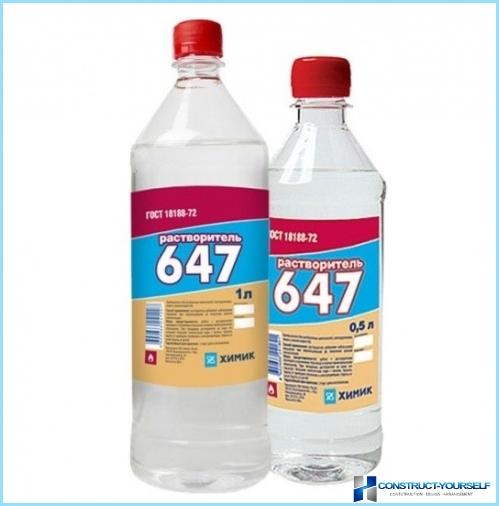
Solvent 647 stamps can be purchased at any hardware store or market in any quantity. This diluent acquire not only specialized companies, but also ordinary consumers for domestic use. The mixture is Packed as in bottles of 0.5 liters and a large capacity for production needs.
The main difference between solvent, brand 646 and 647 is the chemical makeup. If mark 646 contains ethanol, butanol, toluene, acetone and etiltsellozolv, the 647 – butyl acetate, toluene, ethyl acetate and butanol. Despite the similarity of compositions, solvent 647 does not contain in its composition of acetone, making it less aggressive to sensitive surfaces. At the same time, when working with solvent 646 is required to be extremely cautious and careful not to damage the lacquer layer. This is because this part relates to highly active solutions.
Brand 647 is used for dilution of nitrocellulose paints and varnishes, giving them the necessary viscosity. Through solvent 647 is possible quite accurately to remove from the surface of different strokes.
Solvent brand P4 ↑
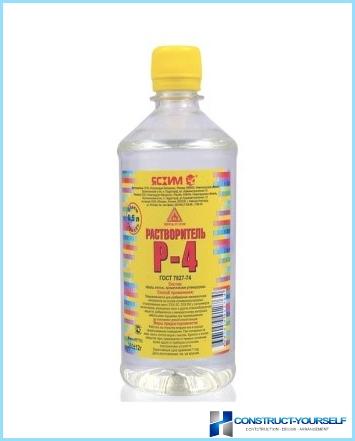
Quite often for painting, use solvent brand P4, a part of which is acetone, toluene and butyl acetate. Typically, this mark is used for dilution of varnishes and paints, dissolution of synthetic and natural film-forming compositions, to bring material and other compositions to the desired thickness and less for the purification of the utensils, tools and arms.
Technical characteristics of the solvent of the brand P4 ↑
Solvent brands of R4 is determined by the GOST as a mixture of acetone (26%), butyl acetate (12%) and toluene (26%). Thinning the composition can be used with most enamels and varnishes, including on the basis of chloride resins. The presence of butyl acetate in the composition of the diluent prevents fading paint and improve its Shine.
As with all solvent, mark P4 has the explosiveness and Flammability easy. Since a couple of butyl acetate, toluene and acetone are heavier than air, they tend to accumulate at the bottom of the room, and their largest concentration is quite explosive. Therefore, when using such mixtures requires adherence to fire safety for flammable and explosive substances. For fighting thinning formulations it is recommended to use fire extinguishers chemical and air-mechanical foam, fine water spray.
Safety measures when working with solvents ↑
Intending to buy the solvent and use it in work, you must take into account the existing sanitary norms. All the components of the solvent has irritating effect on mucous membranes of eyes and respiratory tract.
Carrying out work in confined and enclosed space filled with vapors of the solvent may cause coughing, disorientation, dizziness, dizziness and headache, drug status, as well as severe swelling food poisoning and Central nervous system. So, to avoid such unpleasant experience of work with similar compounds should be conducted with the measures of protection to the eyes and respiratory tract, the use of supply and exhaust ventilation, as well as gauntlets or gloves.
Since almost all thinners refers to flammable substances, it is necessary to treat them very carefully. It is necessary to exclude any possibility of sparks, open flames and Smoking in the vicinity of the solvent.
Solvent mixtures are produced in glass and metal containers with volumes from 0.5-10 liters. The transportation of such compositions is performed only by special cars or in rail tank cars. Data requirements for transportation due to the fact that solvent formulations are highly flammable. Also, the container with the diluent must be protected from direct sunlight and moisture. Solvents should be stored in a dark room with good ventilation.

